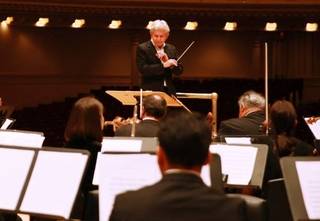|
Back
The Sounds of Central Asia New York
Isaac Stern Auditorium, Carnegie Hall
10/09/2023 -
Tles Kazhgaliev: The Steppe Legend (Symphonic Suite): 1. “Adagio” & 4. “Kyz Kuu”
Lowell Liebermann: Violin Concerto – Chamber Concerto No.1
Sergei Prokofiev: Symphony No.1 “Classical”, Op. 25
Aiman Mussakhajayeva (Violin/Artistic Director), Lowell Liebermann (Piano)
Kazakh State Symphony Orchestra, Andreas Delfs (Conductor)

A. Delfs (© Alexandra Brenyo)
“People’s smiles, the kindly eyes of a hundred people, are hotter than the sun.”
“A wolf cannot get enough of sheep. A man cannot get enough of thinking.”
Kazakh proverbs
Rarely bothering to visit Central Asia, 19th Century composers like Borodin and Rimsky‑Korsakov wrote much music, celebrating “Wild East” of Russia. Last night, Carnegie Hall audiences heard Kazakh music in the flesh, so to speak, in 20th Century works rarely played elsewhere.
The Kazakh State Symphony Orchestra (KSSO) is a large band, with sizeable percussion and brass sections. The strings were quite luscious for good reason. After all, violin soloist Aiman Mussakhajayeva was founder of the Kazakh National University of Arts, from whence come most of the KSSO players. And as Artistic Director of the KSSO, Ms. Mussakhajayeva obviously keeps a strict eye and ear on her pupils.
(Ms. Mussakhajayeva also has the dubious title of People’s Artist of the Republic of Kazakhstan, a titular holdover from their days as a vassalage of the Soviet Union.)
She is a splendid and vivacious soloist, making full use of her 1732 Stradivarius. Rather than playing the usual concertos, though, she teamed up with Lowell Liebermann for two of his major works.
One must wonder about the selections here. For their premiere New York performance, one would have imagined a combination of traditional and new. Familiarity and surprise could have been the hallmarks of any new orchestra.
Instead, the KSSO played two works by American composer Liebermann, and while both were intriguing, it seemed like an embarras des richesses for the composer. (Mr. Liebermann will also be featured tonight in his Frankenstein music at the Church of the Intercession.)
The Violin Concerto was a connected three movements of rhythm and several cadenzas. This is neo‑Romantic music at its best, a sometimes simulacrum of Samuel Barber’s piece. Having heard it the first time, I felt immediately at home with the impassioned opening and its really majestic finale. Ms. Mussakhajayeva has recorded the work, and the KSSO obviously felt comfortable with its varied moods.
Yet it was the following Chamber Concerto for violin, piano and abbreviated orchestra which was absolutely mesmerizing. Part of it was the exotic colors, the undulating quivers and quasi‑Eastern scale passages. Ms. Mussakhajayeva was quite brilliant here. But the awards had to go to the composer on piano. Mr. Liebermann has never appeared in Carnegie Hall as soloist which is a shame. Though his sensitivity, his balance, his tasteful yet rarely aggressive lines had the beauty of a Gothic edifice.

A. Mussakhajayeva, L. Liebermann (© Alexandra Brenyo)
The Kazakh State Symphony Orchestra has a very special relationship with Sergei Prokofiev, essaying his First Symphony. First, the composer himself lived in Alma‑Ata for a while, composing the music for Ivan the Terrible and other films. Then, he wrote five excellent highly emotional transcriptions of Kazakh popular songs, recently discovered and recorded.
Third, the KSSO itself has recorded several Prokofiev symphonies, obviously with a special personal bond.
The “Classical” was taken at a sensibly brisk pace by Maestro Delfs, and the frequent woodwind solos were played with suitable virtuosity. Could one say that this was a truly “classical” rendition? Not quite. Prokofiev provided a seamless orchestral palette where one shouldn’t even notice these solos, where they all became part of the joyous totality. Rather, segment by segment, the Kazakh orchestra provided striking moments. Haydnesque whimsicality (the opening), an engaging walking theme in the second, a very danceable gavotte and a mad finale. The colors were lucid, the strings shimmered, the drums rumbled.
Yet this Symphony doesn’t triumph by velocity and solos. One should be enveloped by an elegance, a touch of Age of Enlightenment graciousness. Give the KSSO time. Two decades is but a mote in the age of any orchestra.
The two works enveloping the concert were by the late Kazakh composer Tles Kazhgaliev. By the opening and closing sections of his ballet The Steppe Legend, one heard a composer whose orchestration was truly a gift. Actually, the opening calls of nature, the lovely cello melodies, the undulating chords and string figurations, could have been written by any minor 1890’s Central European composer. (This piece was written in 1985). But no one doubted the all too short whizz‑bang finale, Mr. Kazhgaliev fusing folk tunes, dances and terrific exhibitionism, bringing the audience to its feet.
I must comment about an after‑concert action. While soloists and conductor took their bows, members of the orchestra walked around shaking hands with their colleagues. It could have been a Kazakh ritual or simply impulsive self-endearment for their own gifts. Such affections were tender gestures, and totally delightful.
Harry Rolnick
|